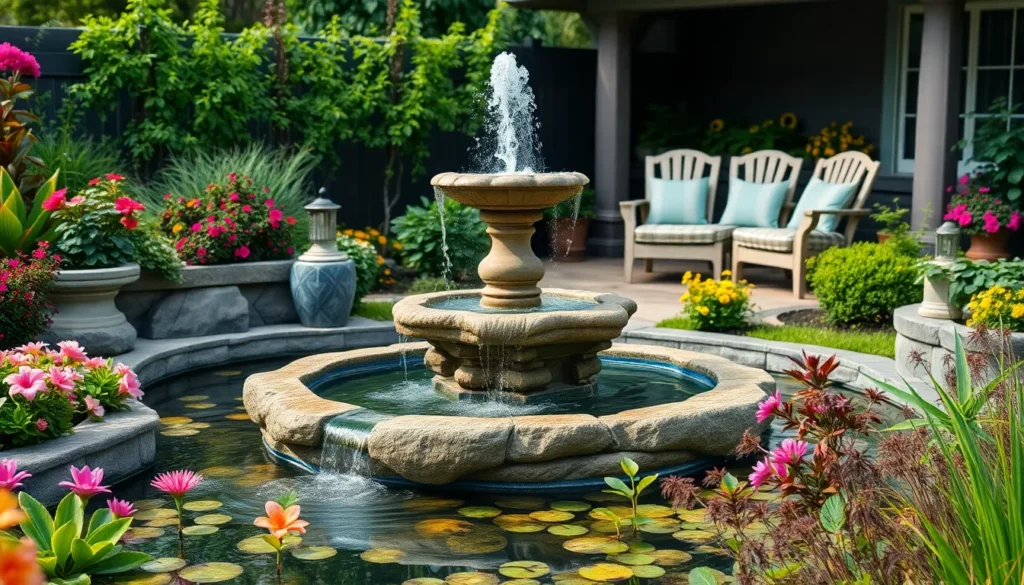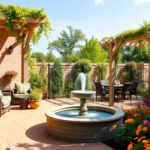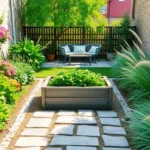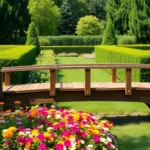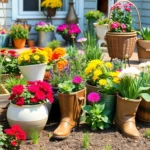Nothing transforms an ordinary garden into a tranquil paradise quite like the gentle sound of flowing water. Whether you’re dreaming of a bubbling fountain centerpiece or a serene pond that reflects the sky water features instantly elevate your outdoor space from simple to spectacular.
We’ve all experienced that magical moment when we stumble upon a garden with a stunning water element. The stress melts away as we listen to the soothing sounds and watch the mesmerizing movement of water. It’s no wonder that homeowners across the country are discovering how these captivating additions can turn their backyards into personal retreats.
From budget-friendly DIY options to elaborate custom installations water features offer something for every garden size and style. They don’t just look beautiful – they attract wildlife create natural cooling zones and can even increase your property value. Ready to jump into the industry of garden water features and discover which option will transform your outdoor sanctuary?
Choose the Right Type of Garden Water Feature for Your Space
Selecting the perfect water feature depends on your garden’s size, style, and maintenance preferences. Each type offers unique benefits that can transform your outdoor space into a peaceful retreat.
Fountains for Classic Elegance
Fountains bring timeless sophistication to any garden setting with their graceful water displays and architectural appeal. We recommend tiered fountains for formal gardens, as they create structured visual interest while producing gentle splashing sounds that mask neighborhood noise. Wall mounted fountains work exceptionally well in small spaces or courtyards, requiring minimal ground space while maximizing vertical impact.
Solar powered fountain options eliminate electrical installation costs and provide eco friendly operation during daylight hours. Traditional stone fountains complement Mediterranean or classical garden designs, while modern metal versions suit contemporary landscapes perfectly. Most fountain installations require 2 to 4 hours of professional setup, depending on electrical and plumbing requirements.
Ponds for Natural Beauty
Ponds create the most naturalistic water feature option, supporting aquatic plants and fish while attracting beneficial wildlife to your garden. We suggest starting with pond sizes between 100 to 200 square feet for beginners, as smaller ponds require more frequent maintenance and temperature fluctuations. Liner ponds offer flexibility in shape and depth, while preformed ponds simplify installation for weekend DIY projects.
Koi ponds need depths of at least 3 feet to protect fish during winter months in colder climates. Plant margins around pond edges with water lilies, cattails, and pickerel rush to create natural filtration and habitat zones. Pond pumps and filtration systems maintain water quality, with most residential ponds requiring 1000 to 2000 gallon per hour circulation rates.
Waterfalls for Dramatic Impact
Waterfalls deliver the most striking visual and auditory experience among garden water features, creating focal points that draw attention from considerable distances. We design waterfall heights between 18 to 36 inches for optimal sound production without overwhelming smaller garden spaces. Natural stone waterfalls blend seamlessly with existing landscaping, while manufactured rock alternatives provide lighter weight options for deck installations.
Pondless waterfalls eliminate standing water concerns while maintaining the dramatic cascading effect through underground reservoir systems. Multi tiered waterfall designs create varied water sounds and extended viewing pleasure as water moves through different levels. Professional waterfall installations typically cost 3000 to 8000 dollars, depending on size and complexity requirements.
Birdbaths for Wildlife Appeal
Birdbaths provide the most affordable and low maintenance water feature option while creating essential wildlife habitat in your garden. We position birdbaths 3 to 4 feet above ground level to give birds clear sightlines for predator detection while drinking and bathing. Shallow basins with depths between 1 to 2 inches accommodate the widest variety of bird species safely.
Heated birdbaths extend wildlife benefits through winter months, preventing ice formation in temperatures down to negative 10 degrees Fahrenheit. Pedestal birdbaths offer classic styling for traditional gardens, while hanging models save ground space in compact areas. Moving water birdbaths with small fountains or drippers attract more bird species than static water sources, increasing wildlife viewing opportunities throughout the day.
Plan the Perfect Location for Maximum Impact
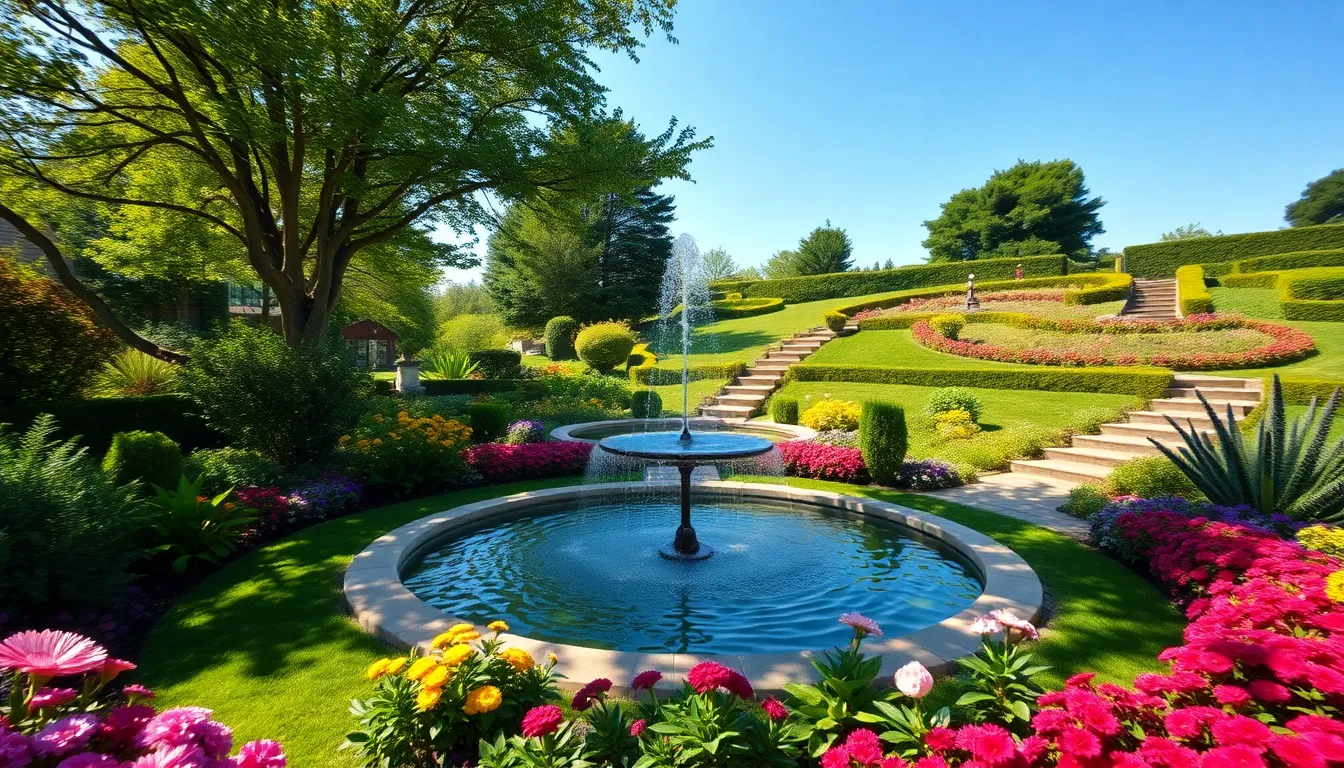
Selecting the ideal spot for your garden water feature determines its success and longevity. We’ll guide you through the essential factors that ensure maximum visual impact and functionality.
Consider Sunlight and Shade Requirements
Sunlight exposure dramatically affects water feature performance and maintenance needs. Ponds require careful balance since excessive sunlight promotes unwanted algae growth that can cloud your water and create ongoing maintenance challenges. Aquatic plants thrive with partial sunlight but struggle in completely shaded areas where photosynthesis becomes limited.
Fountains adapt well to various lighting conditions throughout your garden. We recommend positioning fountains in areas that receive morning sun and afternoon shade for optimal water clarity. Direct sunlight can accelerate water evaporation and affect chlorination treatments if you use them to maintain water quality.
Strategic shade placement extends the lifespan of water feature components. Equipment like pumps and filters perform better when protected from intense heat that can cause premature wear and increased energy consumption.
Evaluate Proximity to Power Sources
Electrical access remains crucial for most garden water features since pumps and lighting systems require consistent power supply. We suggest locating your feature within 50 feet of existing outdoor outlets to minimize installation costs and complexity. Extension cords create safety hazards and aren’t suitable for permanent installations.
Professional electrical installation ensures safe operation and code compliance. Ground fault circuit interrupter (GFCI) protection is mandatory for all water feature electrical connections to prevent dangerous shock hazards. Licensed electricians can install dedicated circuits that handle the exact power requirements of pumps and underwater lighting.
Planning electrical routes before excavation saves time and reduces landscaping disruption. We recommend marking utility lines and planning conduit paths that avoid future garden expansions or hardscaping projects.
Assess Drainage and Ground Conditions
Proper drainage prevents water accumulation that can undermine your feature’s foundation and surrounding industry. Areas with poor drainage create waterlogging issues that damage plant roots and create mosquito breeding grounds. We test drainage by digging a small hole and observing how quickly water dissipates after rainfall.
Ground stability determines the structural integrity of larger water features like ponds and waterfalls. Clay soils provide excellent natural liner support but may require amendments for proper drainage. Sandy soils drain well but need reinforcement to prevent settling that can crack rigid pond liners.
Slope considerations affect water flow patterns and feature positioning. Natural slopes work perfectly for waterfall installations but require careful grading to prevent erosion. Level areas suit fountains and formal ponds that need stable, even foundations for proper operation.
Design Your Garden Water Feature Layout
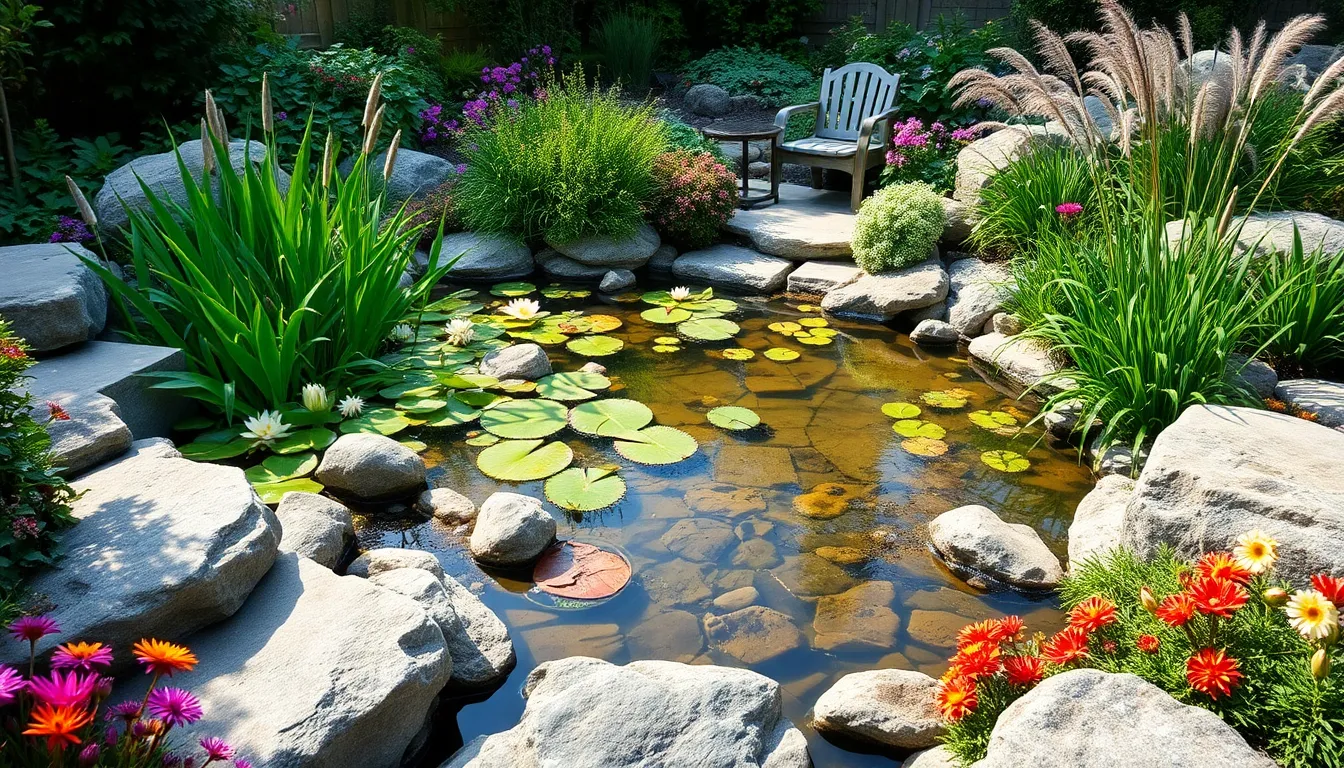
After choosing your ideal water feature type and finding the perfect location, we need to focus on creating a cohesive design that integrates seamlessly with your existing industry.
Create Visual Balance with Surrounding Plants
Plant selection plays a crucial role in making your water feature look natural and established. We recommend choosing aquatic plants for pond installations, such as water lilies, lotus, and cattails, which thrive directly in water environments. Moisture loving plants like hostas, ferns, and astilbe work beautifully around streams and fountain edges where soil stays consistently damp.
Layering different plant heights creates depth and visual interest around your water feature. Place tall ornamental grasses or bamboo in the background, medium sized shrubs like hydrangeas in the middle tier, and low growing groundcovers such as creeping jenny or moss at the water’s edge. This technique draws the eye naturally toward your water element while creating a lush, integrated appearance.
Seasonal variety ensures year round appeal for your water garden design. We suggest incorporating evergreen plants like boxwood or juniper for winter structure, spring bulbs such as daffodils and tulips for early color, summer perennials like black eyed susan, and fall favorites including ornamental kale or asters.
Incorporate Natural Stone and Materials
Natural stone materials enhance the visual appeal of water features while providing durable, low maintenance answers. Flagstone, river rock, and fieldstone blend seamlessly with outdoor environments, creating authentic looking installations that appear to have existed naturally in your industry for years.
Stone placement techniques can dramatically affect your feature’s overall aesthetic impact. We recommend using larger stones as focal points or structural elements, medium sized rocks for creating natural looking edges, and smaller pebbles or gravel for filling gaps and creating smooth transitions between different materials.
Material consistency throughout your garden design creates a cohesive, professional appearance. Choose stone types and colors that complement your home’s exterior, existing hardscaping elements like patios or walkways, and the natural geology of your region for the most authentic results.
Plan Pathways and Viewing Areas
Accessibility planning ensures everyone can enjoy your water feature safely and comfortably. We design clear pathways using materials like stepping stones, mulched trails, or paved walkways that provide stable footing and easy navigation to and around your water element.
Strategic viewing areas maximize your enjoyment of the water feature from multiple perspectives. Create seating spaces using benches, garden chairs, or built in stone seating at different distances and angles from your feature, allowing you to appreciate both close up details and the broader industry integration.
Traffic flow considerations help determine the best pathway routes and viewing spot locations. We suggest observing how you and your family naturally move through your garden space, then designing pathways that enhance these existing patterns while providing optimal water feature access and enjoyment opportunities.
Install Proper Plumbing and Electrical Systems
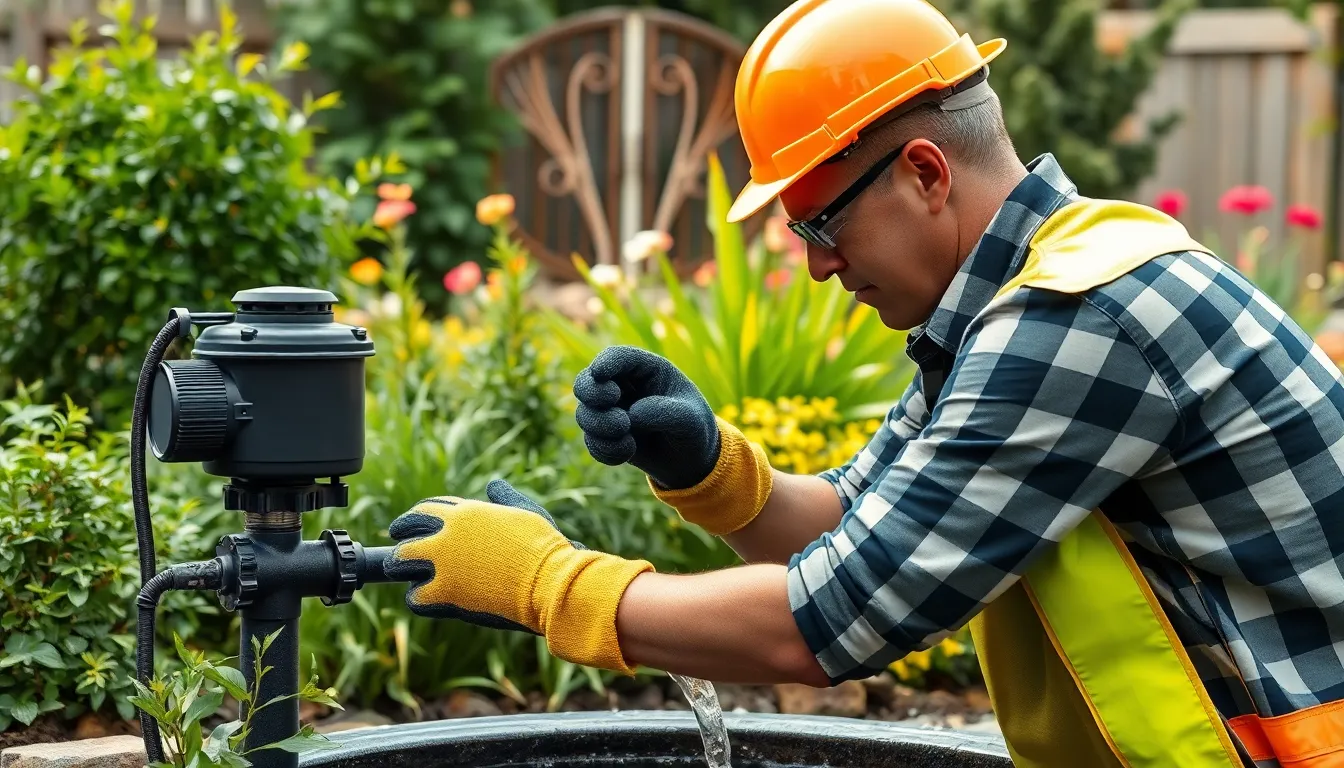
Now that we’ve established the perfect location and design for our water feature, we need to focus on the technical foundation that’ll keep everything running smoothly and safely.
Set Up Water Circulation Systems
Water circulation forms the heart of any successful garden water feature. We’ll need to connect the pump to our water circulation system while ensuring watertight seals throughout the entire setup. Submersible pumps work best since they must remain underwater to prevent running dry and potential damage.
For multi-line systems, we’ll drill holes in deck cylinders to accommodate additional plumbing lines. These holes should be slightly wider than the pipes to allow for easy installation and future maintenance. Proper pump sizing ensures adequate water flow for our exact feature size and height requirements.
Filtration systems become essential components when we’re dealing with larger water features or ponds. These systems maintain water clarity and quality by removing debris and preventing algae buildup. We’ll position filters strategically within our circulation loop to maximize their effectiveness.
Install GFCI Outlets for Safety
GFCI outlets represent our most critical safety measure when working with water and electricity combinations. These specialized outlets automatically shut off power when they detect ground faults, protecting us from dangerous electrical shocks.
We must install GFCI protection for all electrical connections near our water feature. Local electrical codes typically require these outlets within a exact distance of water sources. Professional electricians can ensure proper installation and compliance with safety regulations.
Testing our GFCI outlets monthly helps maintain their protective function. We’ll press the test button to verify the outlet shuts off, then press reset to restore power. This simple maintenance step could prevent serious accidents.
Plan for Drainage and Overflow
Drainage systems prevent water accumulation that could damage our garden or foundation. We’ll install drains at the bottom of our water feature to allow easy water removal during maintenance or winterization periods.
Overflow protection handles excess water from heavy rainfall or system malfunctions. We can design spillways to direct overflow water away from structures, or connect our system to existing drainage networks. These safeguards protect both our investment and surrounding industry.
Strategic placement of drainage elements maintains the aesthetic appeal of our water feature. Hidden drains and disguised overflow channels preserve the natural appearance while providing essential functionality. We’ll test our drainage capacity during initial setup to ensure adequate performance during peak conditions.
Select the Best Plants for Water Features
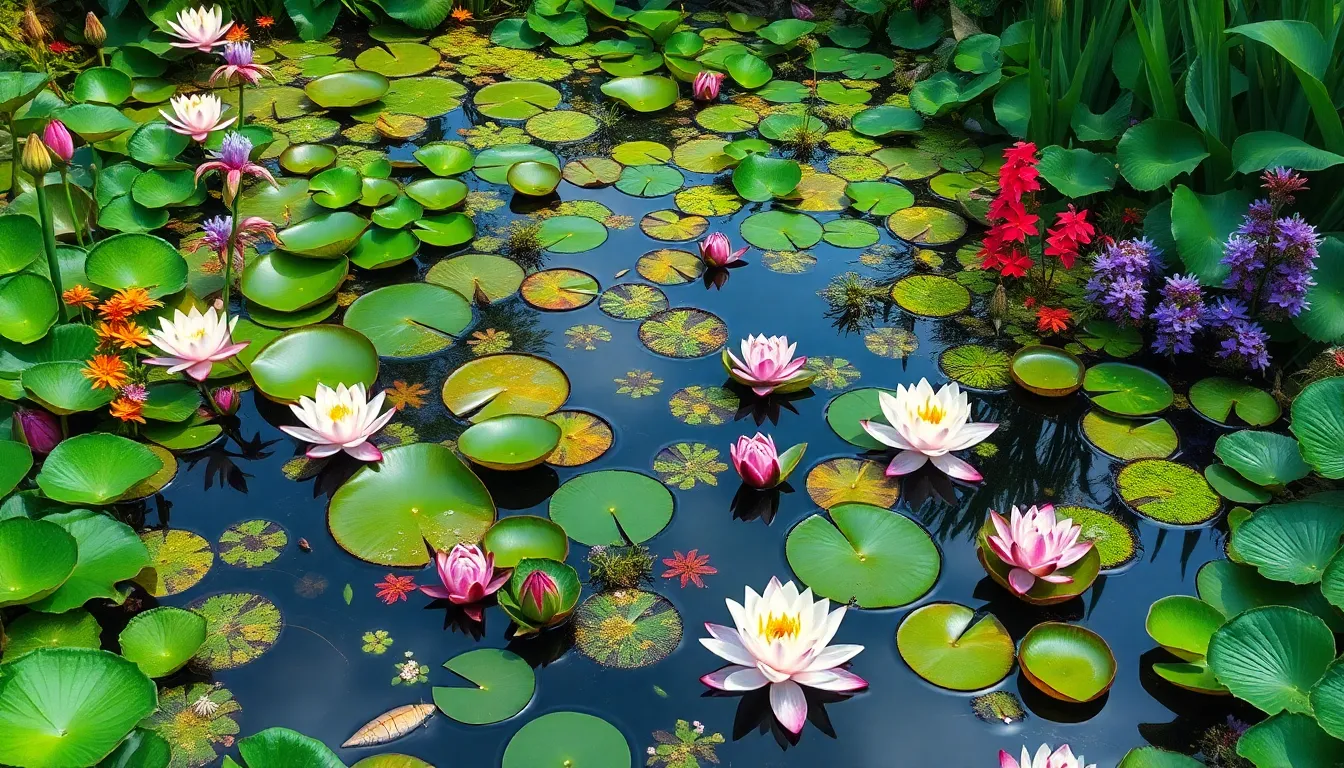
Choosing the right plants transforms your water feature from a simple installation into a thriving aquatic network. We’ll explore three essential plant categories that create visual balance while supporting the health of your water feature.
Choose Aquatic Plants for In-Water Placement
Water lilies (Nymphaea spp.) offer the perfect combination of beauty and functionality with their showy flowers and waxy leaves that provide essential shade while reducing algae growth. These floating beauties create stunning focal points that complement any pond design.
Lotus plants bring exotic elegance to deeper water areas with their large, dramatic leaves and beautiful blooms that rise above the water surface. Their impressive size makes them ideal centerpieces for larger ponds and water gardens.
Pickerel plants thrive in the deeper sections of your pond while requiring minimal maintenance, making them perfect for busy gardeners. These hardy aquatic plants provide essential habitat for fish and beneficial insects while adding vertical interest to your water feature.
Pick Moisture-Loving Perennials for Borders
Japanese iris (Iris ensata) creates striking vertical lines along water edges with sword-shaped leaves and vibrant, colorful flowers that bloom throughout the growing season. These plants bridge the gap between your water feature and surrounding industry beautifully.
Cardinal flower (Lobelia cardinalis) delivers intense red blooms that attract hummingbirds and butterflies to your water garden while thriving in consistently moist soil conditions. This native perennial adds brilliant color from summer through early fall.
Canna plants provide tropical flair with their tall, colorful flower spikes and broad leaves that create dramatic backdrops for smaller water features. These moisture-loving perennials offer season-long interest with continuous blooming cycles.
Add Floating Plants for Surface Coverage
Water hyacinth (Eichhornia crassipes) grows rapidly to provide quick shade coverage with attractive purple flowers and thick, glossy leaves that shelter fish while reducing algae growth. This fast-spreading plant requires regular thinning to maintain balance.
Water lettuce (Pistia stratiotes) offers unique rosette formations that create interesting textural contrasts while serving as natural water filters. These velvety plants multiply quickly to provide effective surface coverage for smaller ponds.
Frogbit (Limnobium spongia) produces charming heart-shaped leaves that resemble miniature water lilies, creating delicate surface patterns perfect for intimate water features. These native plants require less maintenance than traditional water lilies while providing similar aesthetic benefits.
Maintain Your Garden Water Features Year-Round

Keeping our garden water features beautiful and functional requires consistent maintenance throughout the changing seasons. We’ll establish proper care routines that protect our investment and ensure optimal performance year round.
Perform Regular Cleaning and Debris Removal
Weekly maintenance tasks keep our water features operating smoothly and looking their best. We check water levels during each inspection to prevent pump damage from running dry. Filter systems need cleaning and inspection to maintain proper water circulation. Surface debris like leaves, twigs, and organic matter should be skimmed away before it decomposes and affects water quality. Pump operation requires verification to ensure consistent water flow and prevent mechanical issues.
Monthly deep cleaning addresses more intensive maintenance needs that weekly tasks can’t handle. We thoroughly clean pumps and filters to remove accumulated sediment and organic buildup. Aquatic plants receive inspection for overgrowth, dead foliage, and overall health. Partial water changes of 10-20% help maintain optimal water conditions by removing dissolved waste products and replenishing beneficial minerals.
Monitor Water Quality and Chemical Balance
Regular water testing protects both aquatic life and equipment from harmful chemical imbalances. We use testing kits to monitor pH levels, keeping them between 6.5-8.5 for optimal network health. Ammonia levels should remain at zero, as elevated concentrations indicate decomposing organic matter or overcrowding issues. Nitrate and nitrite readings help us track the nitrogen cycle and determine when water changes are necessary. Chemical treatments get adjusted based on test results to maintain balanced water conditions.
Algae prevention strategies maintain crystal clear water and prevent unsightly green blooms. We inspect water features regularly for early signs of algae growth, including green tinting, slimy surfaces, or foul odors. Targeted treatments address exact algae types without harming beneficial bacteria or aquatic plants. Proper filtration, adequate water circulation, and controlled nutrient levels create conditions that naturally discourage excessive algae growth.
Prepare for Winter Weather Protection
Winterization procedures safeguard our water features from freezing temperatures and ice damage. We drain systems completely when possible to eliminate water that could freeze and crack pipes or damage pumps. Pumps require protection through removal and indoor storage or antifreeze addition if drainage isn’t feasible. Cleaning before winter storage prevents debris from hardening and causing spring startup problems.
Insulation techniques protect exposed components from temperature extremes and ice formation. We wrap vulnerable pipes with foam insulation or specialized heating cables designed for outdoor water systems. Equipment housings benefit from weatherproof covers that allow ventilation while blocking wind and precipitation. Strategic placement of insulation materials prevents freeze damage without restricting necessary airflow or drainage.
Seasonal transition planning ensures smooth operation when spring arrives and temperatures rise. We schedule thorough cleaning and system testing before refilling drained features. Preventive algae treatments applied during spring startup help maintain water clarity as biological activity increases. Summer preparation includes establishing regular water level monitoring to compensate for increased evaporation rates.
Enhance Ambiance with Lighting and Accessories
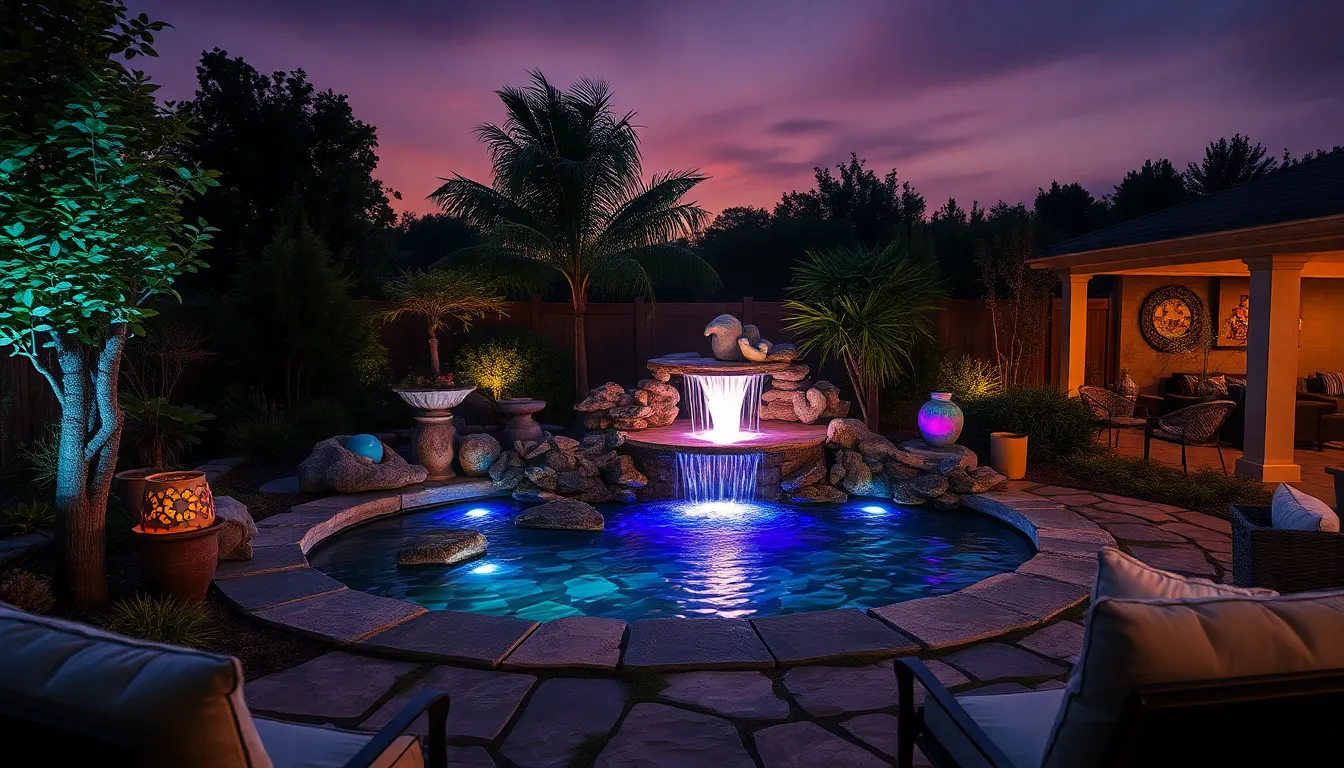
Garden water features truly come alive when we enhance them with thoughtful lighting and decorative accessories. These additions transform our outdoor spaces into enchanting environments that captivate both day and night visitors.
Install Underwater LED Lighting Systems
Underwater LED lighting creates mesmerizing effects by illuminating water features from beneath the surface. We can highlight the natural beauty of ponds and pools with these energy-efficient systems that produce captivating glows during evening hours. Installing these lights beneath waterfalls creates dramatic cascading effects that dance across surrounding surfaces.
Position LED fixtures at strategic depths to maximize visual impact while ensuring proper waterproofing protects electrical components. Multiple color options allow us to customize the atmosphere according to seasons or special occasions. Quality underwater LED systems typically last 25,000 to 50,000 hours and consume 75% less energy than traditional lighting options.
Add Decorative Elements and Sculptures
Decorative sculptures bring personality and artistic flair to our garden water features through carefully selected materials and designs. Stone sculptures offer durability and natural aesthetics that complement pond environments beautifully. Bronze statues develop attractive patina over time while maintaining structural integrity in outdoor conditions.
Ceramic pieces provide vibrant colors and intricate details that serve as focal points near fountains and streams. Abstract designs create modern appeal while classic figurines add timeless elegance to traditional garden settings. Positioning these elements at varying heights creates visual depth and encourages exploration throughout our water garden spaces.
Scale considerations ensure sculptures complement rather than overwhelm existing water features and surrounding plantings.
Incorporate Seating Areas for Relaxation
Seating areas maximize our enjoyment of garden water features by providing comfortable spots to appreciate soothing water sounds and tranquil views. Stone benches offer permanent answers that weather naturally while maintaining structural stability through seasons. Wooden chairs and tables create inviting gathering spaces for family conversations and quiet reflection moments.
Strategic placement ensures optimal viewing angles of water features while maintaining safe distances from electrical components and water edges. Built-in seating using retaining wall designs serves dual purposes by defining space boundaries and providing comfortable resting spots.
Cushioned outdoor furniture adds comfort for extended relaxation sessions while removable elements allow flexibility in arrangement and seasonal storage.
Troubleshoot Common Garden Water Feature Problems
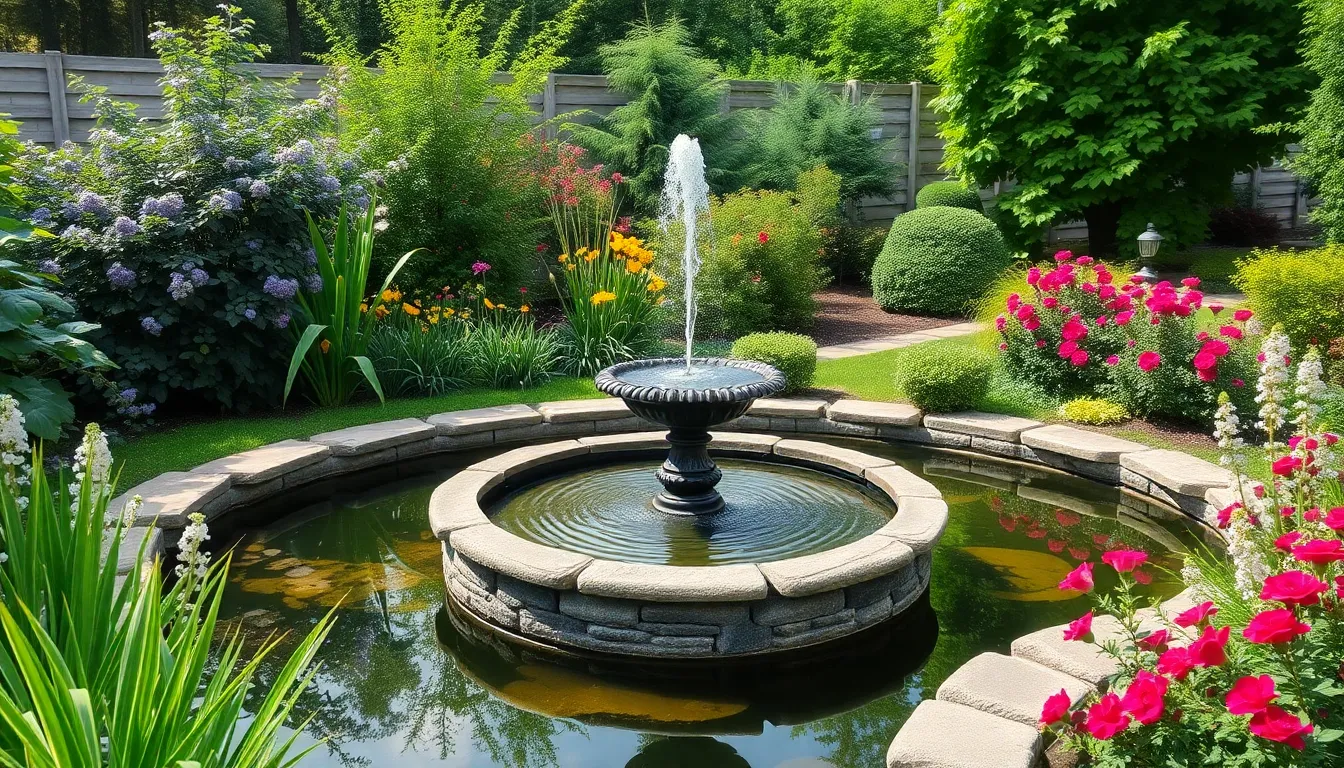
Even the most well-maintained garden water features can encounter issues that affect their beauty and functionality. We’ll guide you through solving the most common problems to keep your water feature running smoothly.
Address Algae Growth and Water Clarity Issues
Identify the root cause of algae problems by checking nutrient levels in your water. Excessive fish food and organic debris create perfect conditions for algae growth, which we can prevent through careful feeding practices and regular water changes.
Carry out targeted answers using algae control products combined with increased water circulation. We recommend testing water quality regularly to maintain optimal pH levels and ensure adequate water flow prevents stagnation that encourages algae development.
Take preventive measures by skimming surface debris daily and cleaning filters weekly. Regular removal of organic matter significantly reduces the nutrients that fuel algae growth, keeping your water crystal clear.
Fix Pump and Circulation Problems
Check pump operation first by ensuring it’s completely submerged in water. Pumps that aren’t fully underwater work harder and risk burning out, which can lead to costly replacements and system failures.
Inspect electrical connections thoroughly to verify all wiring remains secure and functional. Loose connections create safety hazards and can cause intermittent pump operation that disrupts your water feature’s performance.
Clean the pump regularly by removing debris from intake areas and internal components. We suggest monthly cleaning to prevent clogs that reduce circulation efficiency and strain the motor.
Resolve Leaks and Structural Damage
Inspect for leaks systematically by checking pond liners and seals for signs of wear or punctures. Prompt repair of even small leaks prevents important water loss and protects your investment in the water feature.
Monitor water levels consistently to ensure pumps operate correctly and avoid structural stress. Maintaining adequate water depth protects equipment and prevents damage from running dry.
Address erosion immediately when you notice edge deterioration or surrounding soil displacement. Regular inspection and repair of erosion damage maintains structural integrity and prevents more extensive problems that require costly reconstruction.
Budget Wisely for Your Garden Water Feature Project
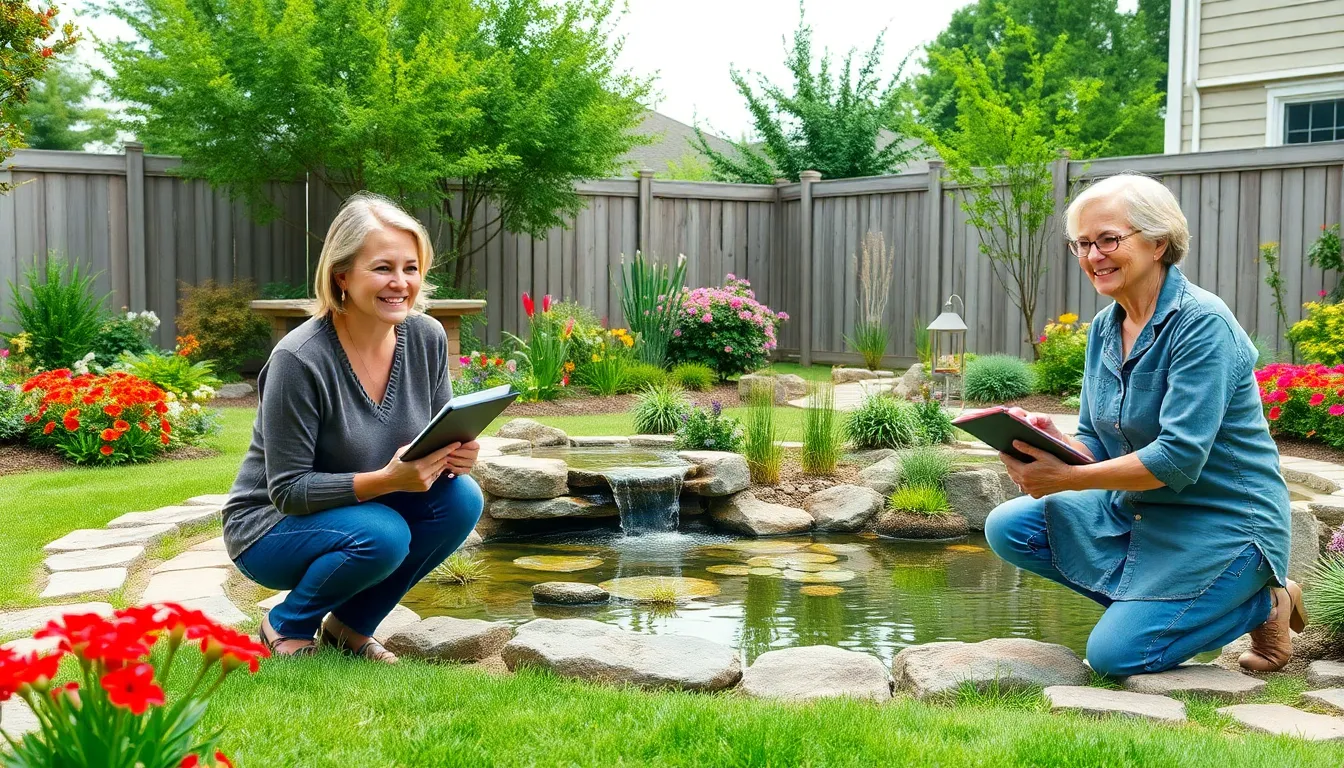
Smart budgeting ensures we’ll create the perfect water feature without overspending. Understanding the full cost picture helps us make informed decisions that align with our garden goals and financial resources.
Compare Costs of DIY Versus Professional Installation
DIY garden fountains offer important savings with material costs ranging from $50 to $1,000 for most projects. Small water features like tabletop fountains, birdbaths, or simple pond kits require minimal tools and basic skills that most homeowners can handle independently.
Professional installation averages $1,100 to $7,500 nationally, with labor costs adding $40 to $65 per hour to our project budget. Complex features requiring electrical work, industry changes, or custom stonework make professional expertise essential for proper installation and long-term functionality.
Custom waterfalls and large pond systems often exceed $10,000 when professionally installed, reflecting the specialized knowledge needed for drainage, filtration, and structural integrity. We’ll save money on simple projects but should invest in professionals for elaborate designs that require permits or utility connections.
Total project costs typically range from $928 to $4,958 for most homeowners choosing professional installation, while DIY enthusiasts can create beautiful features for under $1,000. Materials like concrete, natural stone, or custom components increase expenses regardless of our installation approach.
Factor in Ongoing Maintenance Expenses
Regular cleaning prevents algae buildup and keeps our water feature looking pristine throughout the growing season. Weekly debris removal and monthly deep cleaning maintain water clarity and prevent pump damage from accumulated leaves and organic matter.
Pump maintenance represents our largest ongoing expense, with replacement or repair needed every 3 to 5 years depending on usage and water quality. Replacement pumps cost $50 to $500 based on size and features, making proper care essential for extending equipment life.
Winterization protects our investment in cold climates by preventing freeze damage to pipes, pumps, and decorative elements. Annual preparation costs include drain plugs, protective covers, and sometimes professional service calls for complex systems.
Water usage increases slightly with most recirculating systems, though efficient pumps minimize the impact on monthly utility bills. Evaporation replacement and occasional full water changes add modest ongoing costs to our maintenance budget.
Explore Financing Options and Seasonal Deals
Retailer financing through garden centers and home improvement stores offers installment plans that spread costs over 6 to 24 months. Store credit programs often include promotional periods with zero interest for qualified buyers purchasing complete water feature packages.
Bank loans and home equity lines of credit provide funding for larger projects exceeding $5,000, with competitive interest rates for homeowners with good credit. Personal loans work well for mid-range features when we prefer fixed monthly payments over variable credit lines.
Seasonal deals during fall and early spring offer substantial discounts when demand drops after peak installation seasons. End-of-season clearance sales can reduce costs by 30 to 50 percent on fountains, pumps, and decorative accessories.
Multiple professional quotes ensure competitive pricing for installation services, with savings of $500 to $2,000 common when contractors compete for our business. Off-season scheduling often includes labor discounts when landscaping professionals have lighter workloads during slower months.
Conclusion
We’ve explored the comprehensive journey of transforming your outdoor space with garden water features—from initial planning and design to technical installation and long-term care. These aquatic elements offer far more than visual appeal; they create living ecosystems that bring tranquility and natural beauty to any garden setting.
Whether you’re considering a simple fountain or an elaborate pond system your investment will reward you with years of peaceful enjoyment. The key lies in thoughtful planning proper installation and consistent maintenance practices that we’ve outlined throughout this guide.
Your garden water feature awaits—it’s time to turn your outdoor vision into a soothing reality that you’ll treasure for seasons to come.
Frequently Asked Questions
What are the main benefits of adding water features to my garden?
Water features create a tranquil atmosphere with soothing sounds, attract wildlife like birds and butterflies, provide natural cooling zones during hot weather, and can potentially increase your property value. They also serve as beautiful focal points that enhance the overall aesthetic appeal of your outdoor space while offering a peaceful retreat for relaxation.
What types of water features can I choose from for my garden?
Popular options include fountains, ponds, waterfalls, and birdbaths. Each offers unique benefits: fountains provide continuous water movement and sound, ponds support aquatic plants and fish, waterfalls create dramatic visual impact, and birdbaths are simple, affordable options that attract wildlife while requiring minimal maintenance.
How do I choose the right location for my water feature?
Consider sunlight and shade requirements for your chosen feature, ensure proximity to power sources for pumps and lighting, and verify proper drainage to prevent water accumulation. The location should maximize visual impact from key viewing areas like patios or windows while maintaining accessibility for maintenance tasks.
What plants work best around water features?
Choose from three categories: aquatic plants like water lilies and lotus for in-water placement, moisture-loving perennials such as Japanese iris and cardinal flower for borders, and floating plants like water hyacinth for surface coverage. Layer different plant heights to create depth and visual interest throughout the seasons.
Should I install a water feature myself or hire professionals?
DIY installation offers significant cost savings and personal satisfaction but requires time, tools, and basic technical skills. Professional installation ensures proper plumbing, electrical work, and compliance with safety codes, though costs range significantly based on complexity. Consider your budget, skills, and the feature’s complexity when deciding.
How do I maintain my water feature throughout the year?
Regular maintenance includes cleaning debris, monitoring water quality, preventing algae growth, and checking pump operation. Seasonal tasks involve winterization to protect against freezing, system testing during temperature changes, and adjusting chemical balance. Consistent care ensures optimal function and extends your feature’s lifespan.
What common problems might occur with water features?
Common issues include algae growth from excess sunlight or nutrients, pump failures affecting circulation, and leaks causing water loss. Solutions involve proper filtration, regular cleaning, strategic plant placement for shade, routine pump maintenance, and prompt leak repairs to protect your investment and maintain functionality.
How much should I budget for a garden water feature project?
Costs vary widely from affordable DIY birdbaths under $100 to custom professional installations exceeding $10,000. Factor in ongoing expenses like electricity, water, maintenance supplies, and seasonal care. Consider financing options, seasonal deals, and start with smaller features that can be expanded over time.

